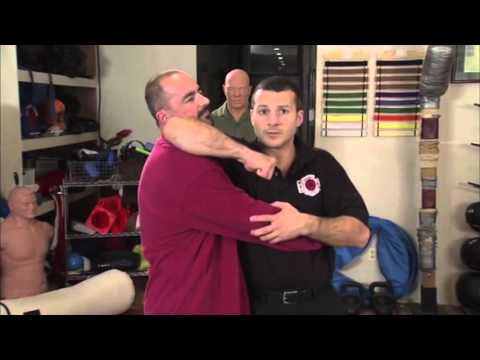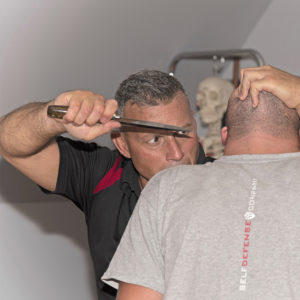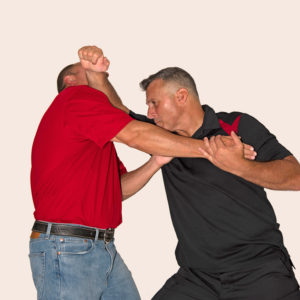My instructor once told me..."Your favorite technique is the one that works." And while I agree 100%...I can't help but have a few personal favorites like this little sneaky move....
It's called the Elbow Spike and you can use it's great for creating space is extremely close situations...
The Elbow Spike is great in a crowd, a bar or any place where you're forced to be in close proximity of your attacker. We also use this in Guardian Weapon Retention and Police Combatives (2 bonus programs with the Elite Training Package). The scenario breaks down like this...
Target gets in your personal space...ELBOW SPIKE - Edge of hand...back up, create space and draw your weapon. Practice that drill until it becomes INSTINCTIVE and CONVULSIVE.
To see exactly what I'm talking about...unlock Elite below...











Like!! Great article post.Really thank you! Really Cool.
Great information. The elbow spike is a very useful tool to add to your kit. ?
Head, knees and elbows are are very effective at close range. They’re basic move one can use under duress.
Absolutely Jeff
The tools you are referring to are awesome in an extreme close quarters situation. Think in terms of two distances. Handshake range and in your face range. Handshake range you have your primary strikes (edge of hands, palm strikes, hammerfists etc) and in extreme close quarters you have secondary tools such as headbutts, ripping, maiming and strikes like elbows and knees.
The elbow spike is useful in both ranges which makes it very cool and effective.
Obviously an effective move. But I can’t help thinking training with a pad is hopelessly unrealistic. Of course one would say you have to to protect your training partner. I dont think practising with a pad helps, as that is NOT what’s going to happen in a real encounter. Better you train and you guys demonstrate it too in super slow mode. But I know, we wanna hear the “bam” “bam” on the pads to add a certain realism & so students will be retained and maintain their interest. But you dont have to go all out in practice. I have ceased practising at self defense classes because of stupid avoidable injuries if people had just slowed down.
The speed’ll happen automatically in a real life situation. Also, if the first strike with the elbow connects, he’s not just going to “react” or just going to stand there, he’s gonna completely turn around covering his injury & likely even to drop a bit, so should also train with that in mind.
You’re overthinking this. In an assault you’re either attacking or getting attacked. Your targets reaction will be to move out of the way and back up…this makes it basically impossible for them to generate power and mount an offensive.
You fail when you stop.
You must practice hitting and taking ground.
Glenn
You make some incredibly valid points regarding the use of pads. What I can tell you from teaching pad holding to my instructors and using it with my students is proper pad feeding is an art. It is a skill in itself that most instructors know nothing about. When I work my students I can use focus mitts and allow them to train pretty realistically and allow for full force strikes. We are able to mitigate the risk of injuries but as I said this is a skill and good pad holders/feeders are very few and far between. I will release some footage over the next bit of how I train with pads just to show you how it can look when done properly. But you definitely aren’t wrong with your points.
One place I completely disagree in is the comment of the speed will just come during the altercation. When we start to look at what happens to the body under the adrenal stress dump you are going to respond with how you train. The brain goes from conscious brain to mid brain and it searches for information on the hard drive (your subconscious brain) on how to deal with this. If you train slow, without impact, without stress, without reality then when the moment of truth arrives you have nothing to fall back on. Damian made some excellent points on this as well.
Look – no matter what you’re training… if you’re actually fighting… you got to go to a dark place. And you can’t do that without actually going hard.
Sure… you can go through the motions slowly through the learning process and you can’t go that hard too often – but here’s the secret…
It’s better to go hard a couple of times than to go slow many times.
Literally training in short, hard bursts is best.
I often equate learning self defense to learning golf. The only way to be able to compete at a high level in golf is to simulate the pressure. That is why, when playing with friends or whoever, we often gamble, or play in as many tournaments as possible in order to get used to the pressure.
In learning self defense, there is no way you will know how you will react in a real life assault unless you’ve either experienced it before, or you train hard for it. Most assailants have a huge advantage over us because they’ve learned violence through experience. Therefore, we must simulate the best we can. Pad work is a hugely important component of that training since we learn how to hit hard. Hitting hard is one of the most basic and important things I teach my students.
Just my two cents.
Glen,
I, and several combatives students and instructors that I know practice combative Tai Chi. However, every one of us also train hard on pads, body offensive bags, and heavy punching bags. You can have it both ways. The slower movements perfect your muscle memory (PERFECT repetition makes perfect) and the “going hard” prepares you for the actual combat.
and BTW, if pads or bags are causing “avoidable injuries” you’re doing it incorrectly. This saying ………
Oral (OK) Neal L-5
Totally agree with you OK… I teach self defense movements the same way I teach the golf swing…I break them down, do them slowly piece by piece, then blend the movements together slowly. You’ve got to be able to do it slow BEFORE you can do it fast!
Absolutely L-5
I love the Elbow Spike, it’s an excellent tool to add to your arsenal.
Hi Damian,
Thank you for posting this article i have personally used this technique…..many years ago an attacker tried to head butt me but not from the front but from my left side, i saw the movement and lifted up my left arm in the elbow strike, his head made lovely contact with the point of my elbow causing him to stagger backwards…he finished the fight before it had even started!
Thx again Damian! Awesome close quarter instruction, “I love the basic practicality of your approach”. It makes the best survival sense to me, it’s easy to learn, efficient, brutally effective, which in my estimation, is EXACTLY what we need if the shit ever hits the fan. Many other defensive systems teach unnecessary complex movements which introduce greater chance of mistakes and failure under stress, including the consequence of being brutalized by one or more thugs. So I have long abandoned much of this type of past instruction in favor of the Self-defense training system.